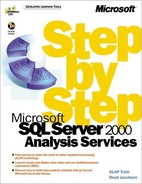Chapter 5. Office 2000 Analysis Components
Dr. Seuss once wrote a story about a mother who had 23 sons and named them all Dave. Even if you haven’t read the story, you can imagine the chaos that ensued. Unfortunately, the Microsoft SQL Server 2000 Analysis Services designers didn’t seem to have read their Dr. Seuss. Office 2000 includes three distinct components that have PivotTable as part of the component name, and all three components have some relationship to Analysis Services.
The first PivotTable is the PivotTable Service, which is included as part of Analysis Services but which is also installed as part of Office 2000. The PivotTable Service functions as the client liaison to the Analysis server, but it’s also capable of creating and communicating with local cubes that don’t require the Analysis server at all. The final section of this chapter will explain how to use the PivotTable Service to create and use local cubes.
The second PivotTable is the PivotTable report feature in Excel. The first known use of the name PivotTable was in the Excel PivotTable report feature. An Excel PivotTable report allows you to select and cross-tabulate numerical values in much the same way you do with an OLAP cube. In earlier versions of Excel, a PivotTable report could retrieve values only from a relational data source. In Excel 2000, a PivotTable report can also present data directly from an OLAP cube. The first section of this chapter will explain how to create and use an Excel PivotTable report.
The third PivotTable is the Office PivotTable list feature that is included as part of the Office Web Components. The Office PivotTable list performs many of the same functions as an Excel PivotTable report, but it includes capabilities that aren’t available in the Excel component. Also, an Office PivotTable list is an ActiveX control, which means that you can use one in any application that can display an ActiveX control, not just as part of an Excel workbook. You can include an Office PivotTable list on a Web page, as part of a Microsoft Visual Basic application, in a Microsoft Word document, in a Microsoft PowerPoint presentation, or even in an Excel workbook. The second section of this chapter explains how to work with an Office PivotTable list.
